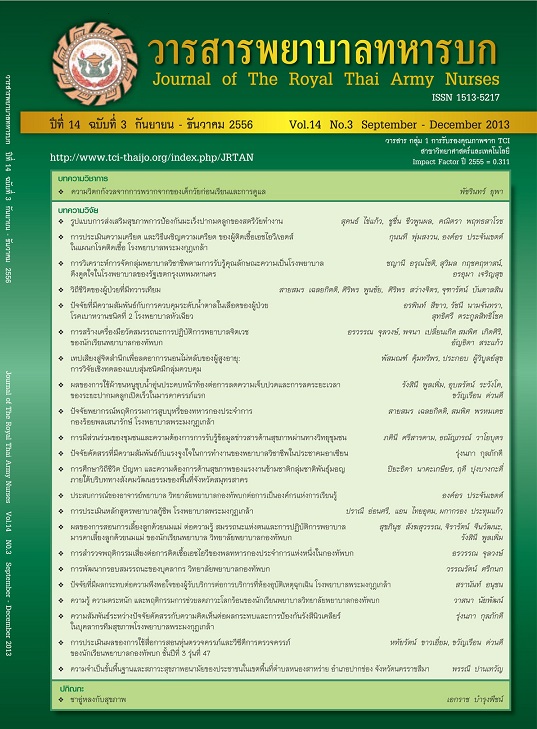การสำรวจพฤติกรรมเสี่ยงต่อการติดเชื้อเอชไอวีของพลทหารกองประจำการแห่งหนึ่งในกองทัพบก Exploring Risky Behaviors Related to HIV Infection in Thai Army Conscripts
Keywords:
พฤติกรรมเสี่ยงต่อการติดเชื้อเอชไอวี, พลทหารกองประจำการ, Risky behaviors related to HIV infection, army conscriptsAbstract
พลทหารกองประจำการ จัดอยู่ในกลุ่มที่ต้องเฝ้าระวังการติดเชื้อ HIV เนื่องจากอยู่ในกลุ่มวัยเจริญพันธุ์และต้องเปลี่ยนวิถีชีวิต สภาพแวดล้อม เพื่อนฝูง และลักษณะงานที่ต้องอยู่ภายใต้กฎระเบียบต่าง ๆ อาจเกิดความเครียดและต้องการระบายความเครียดด้วยวิธีการต่าง ๆ ซึ่งอาจทำให้เพิ่มความเสี่ยงต่อการยั่วยุให้เกิดพฤติกรรมเสี่ยงของการติดเชื้อ HIV ได้ การวิจัยครั้งนี้มีวัตถุประสงค์เพื่อสำรวจพฤติกรรมเสี่ยงต่อการติดเชื้อเอชไอวีของพลทหารกองประจำการ รูปแบบการวิจัย: การวิจัยเชิงพรรณนา การดำเนินการวิจัย: แบ่งเป็น 2 ระยะ (1) กลุ่มตัวอย่างเป็นพลทหารกองประจำการ จำนวน 387 คน คัดเลือกโดยวิธีสุ่มแบบ
ชั้นภูมิ ทำการตอบแบบสำรวจพฤติกรรมเสี่ยงต่อการติดเชื้อเอชไอวี จากนั้นจัดแบ่งกลุ่มตัวอย่างออกเป็น 2 กลุ่มตามพฤติกรรมเสี่ยงต่อการติดเชื้อเอชไอวีได้แก่กลุ่มที่มีพฤติกรรมเสี่ยงและกลุ่มที่ไม่มีพฤติกรรมเสี่ยง (2) คัดเลือกแบบเฉพาะเจาะจงจากกลุ่มตัวอย่างในระยะที่ 1 จากทั้งสองกลุ่ม ๆ ละ 8 คนโดยการสนทนากลุ่ม การวิเคราะห์ข้อมูล: ข้อมูลเชิงปริมาณวิเคราะห์โดยค่าเฉลี่ยและส่วนเบี่ยงเบนมาตรฐาน ส่วนข้อมูลเชิงคุณภาพวิเคราะห์เชิงเนื้อหา ผลการวิจัย: พฤติกรรมเสี่ยงต่อการติดเชื้อเอชไอวีโดยรวมอยู่ใน
ระดับไม่เคยมีพฤติกรรมเสี่ยงถึงมีพฤติกรรมเสี่ยงในระดับต่ำเมื่อพิจารณารายด้าน พบว่าพฤติกรรมเสี่ยงต่อการติดเชื้อเอชไอวีมากที่สุดได้แก่พฤติกรรมการบริโภคสุรา /สารเสพติด รองลงมาได้แก่ด้านชีวิตประจำวันและด้านการมีเพศสัมพันธ์ตามลำดับ ( = 1.34, 0.93, และ 0.64) ข้อมูลเชิงคุณภาพสนับสนุนกับข้อมูลเชิงปริมาณในประเด็นของพฤติกรรมการดื่มสุรามีอิทธิพลต่อการมีพฤติกรรมเสี่ยงด้านการมีเพศสัมพันธ์ที่ไม่ปลอดภัยซึ่งผลการวิจัยจะเป็นแนวทางให้กองทัพในการส่งเสริมพฤติกรรมสุขภาพที่ดีและป้องกัน
พฤติกรรมเสี่ยงในพลทหารกองประจำการ
Thai army conscripts are one of those most at risk for HIV infection, and continue to experience a high rate of contracting the disease. Factors put conscripts at risk of HIV infection is by engaging in unsafe sex with commercial sex workers, their puberty period, changing life style and working environment, and stress from military training. The purpose was to explore risky behaviors related to HIV infection in the army conscripts:
Research design: A descriptive research. Methods: there were two phases: phase I, data collection included (1) 387 conscripts were selected by using stratified random sampling technique, and completed a questionnaire
about behaviors related to HIV infection. The result of this phase was used to divide the conscripts into 2 separated groups based on their behaviors related to HIV infection including (1) risky behaviors, and (2) non-risky or healthy behaviors. Phase II, Focus groups were used to collect data separately from 8 conscripts in each group based on their behaviors associated with HIV infection. Data analysis: mean, SD were
conducted for the quantitative data, and content analysis were used to analyze the qualitative data. Results:The study revealed that an overall the mean score of behaviors of Thai army conscripts fell between no and
slightly low risky behaviors. Looking at each part of risky behaviors related to HIV infection, it was found that alcohol/ drug use has highest scores, followed by daily living, and sexual activities ( = 1.34, 0.93, and 0.64),
respectively. The qualitative data supported the quantitative findings which focus on alcohol use was influencing unsafe sex behaviors. The study results were used to be a guideline for the army to promote healthy
behaviors and prevent risky behaviors in the Thai army conscripts.
Downloads
Downloads
How to Cite
Issue
Section
License
บทความหรือข้อคิดเห็นใดใดที่ปรากฏในวารสารพยาบาลทหารบกเป็นวรรณกรรมของผู้เขียน ซึ่งบรรณาธิการหรือสมาคมพยาบาลทหารบก ไม่จำเป็นต้องเห็นด้วย
บทความที่ได้รับการตีพิมพ์เป็นลิขสิทธิ์ของวารสารพยาบาลทหารบก
The ideas and opinions expressed in the Journal of The Royal Thai Army Nurses are those of the authors and not necessarily those
of the editor or Royal Thai Army Nurses Association.






